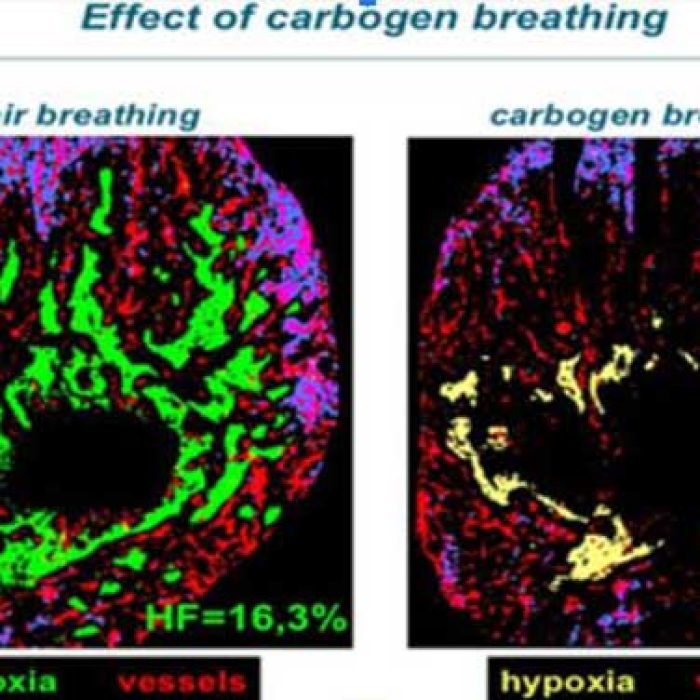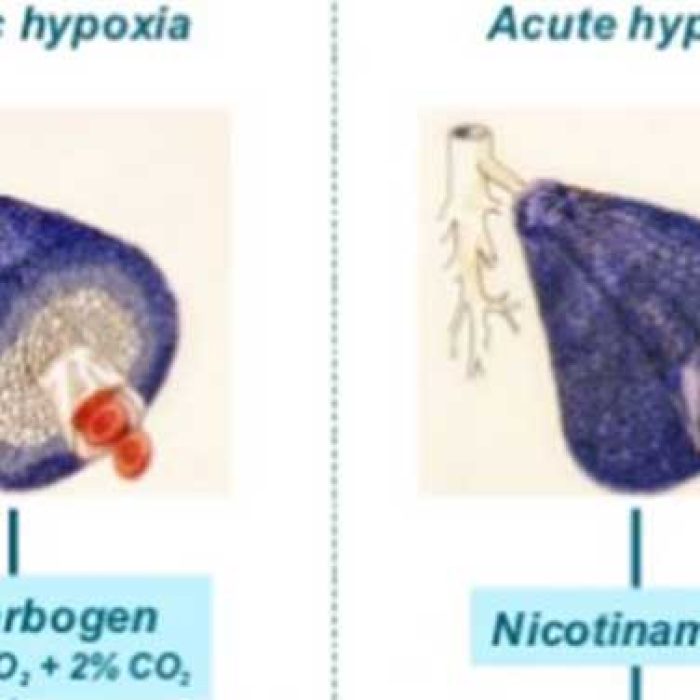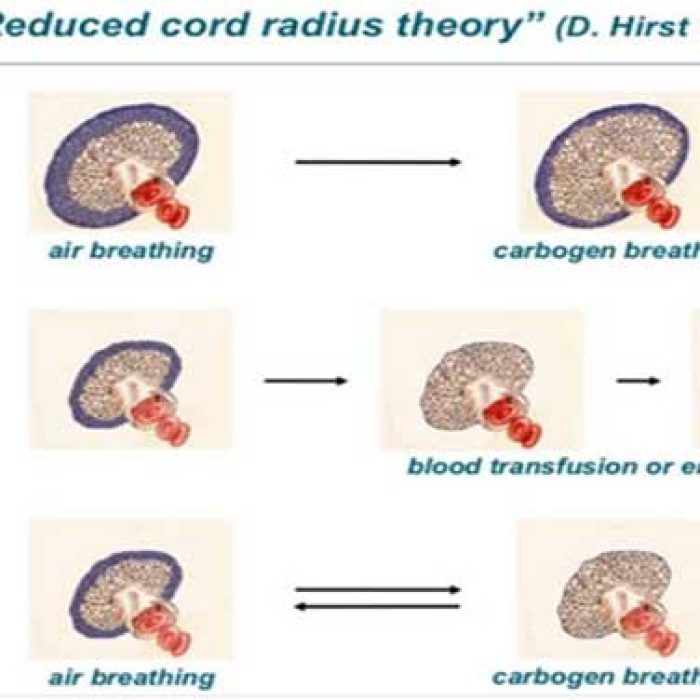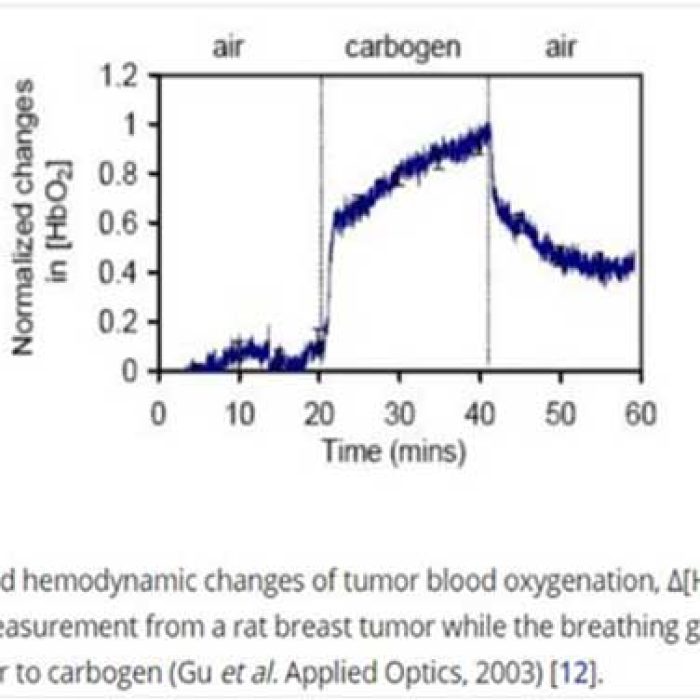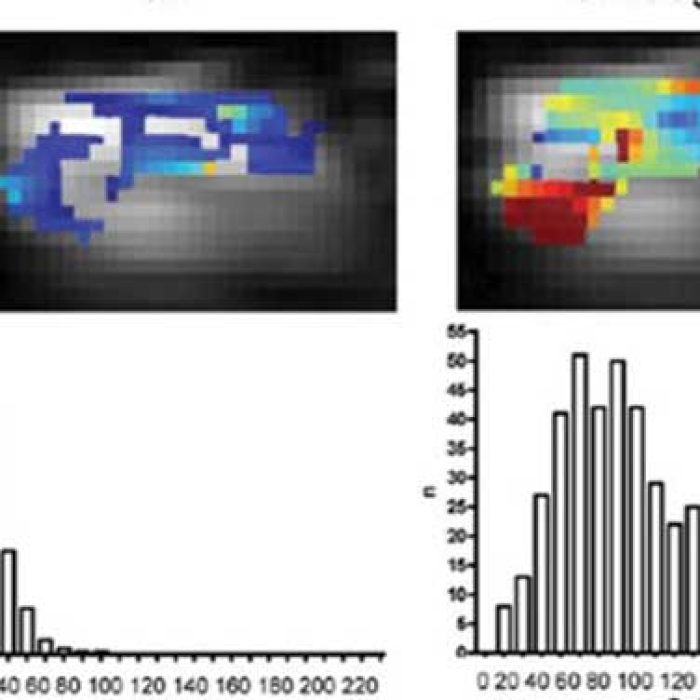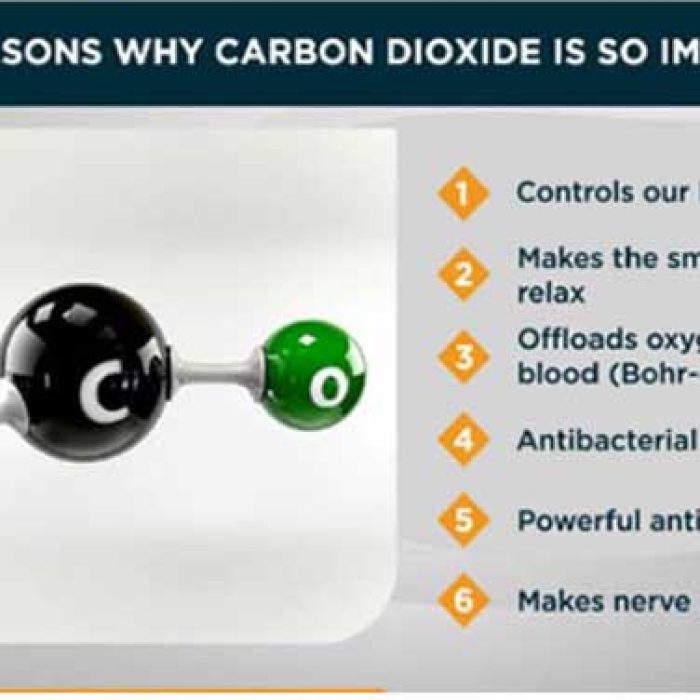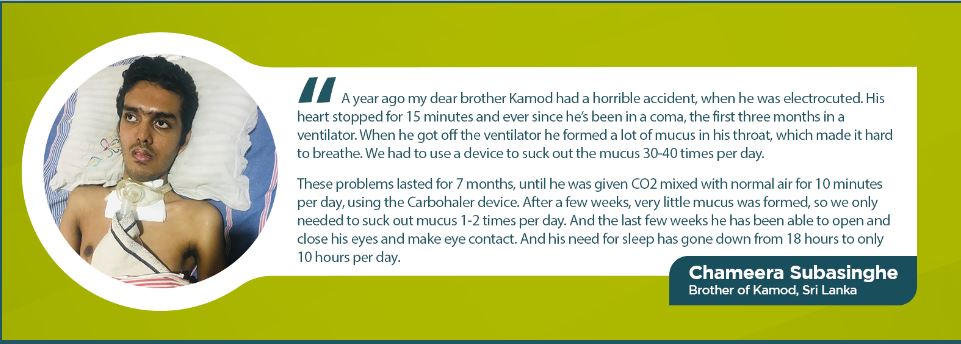CO2inhaler
Oxygenate Your Cells and Improve Your Health Breathing CO2 enriched air
Carbon dioxide is often thought of as a waste gas that we breathe out. So why create a device that allows you to breathe in higher levels of CO2, up to 7%? First we must address why we blow off so much CO2 in each of our exhales. The reason has to do with the partial pressure of the gases. At sea level for example the partial pressure of gases such as oxygen is higher, so that causes us to breathe off more CO2 than is necessary. For example at a higher altitude such as up in the mountains, atmospheric pressure is less so our bodies tend to retain more CO2 once we’ve adapted to altitude. You may have heard of or experienced yourself, altitude sickness. The work of Samual B Childs, Hannibal Hamlin and Yandell Henderson performed a study in 1935 hiking up the mountain to a peak of 14,100 feet.
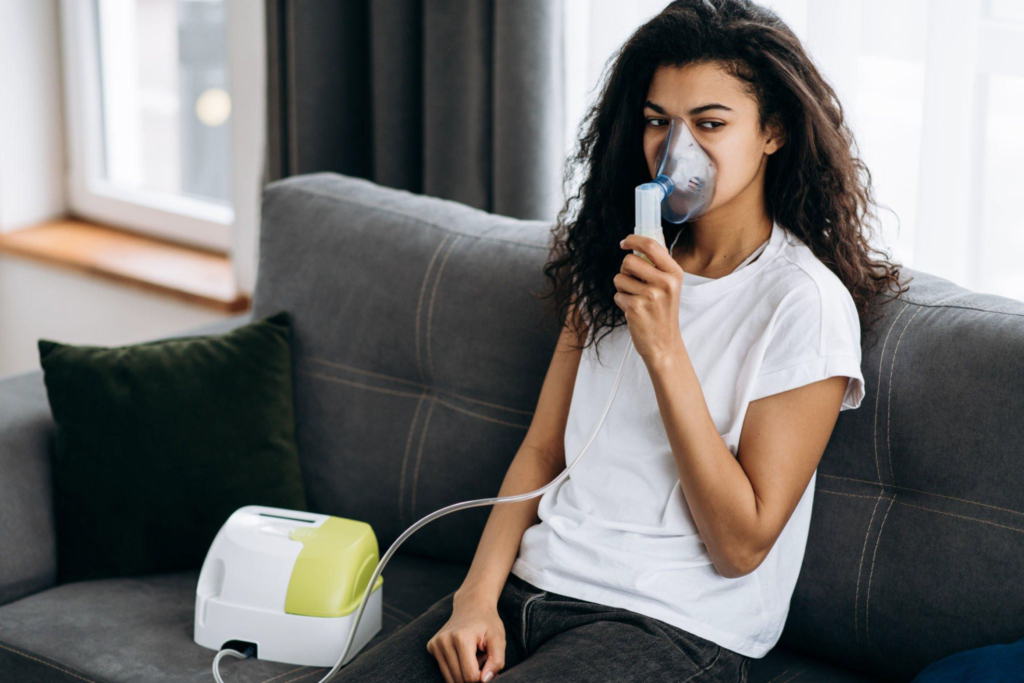
TWO WAYS TO PAY
PAY WITH CARD
$
700
MONTHLY FINANCING
$
39
/month
Based on 24-Month Financing Eligibility
Possible Value of Inhalation of Carbon Dioxide in Climbing Great Altitudes
Our conclusions are that, at least up to an altitude of 14,000 ft. (barometric pressure 450 mm.) inhalation of a small amount of carbon dioxide with the inspired air is distinctly beneficial in protecting against both acapnia and anoxia duiing and after vigorous physical exertion. Another reason why we blow off too much carbon dioxide is hyperventilation. Hyperventilation is when we breathe either too rapidly or too deeply. There are many contributing factors towards hyperventilation such as: Issues with cellular respiration, Mouth breathing, Low CO2 tolerance and more
One of the consequences of overbreathing or hyperventilation is that we blow off too much CO2. While you may think CO2 is a waste product it actually has very important functions in the body. Which is one of the reasons why breathing carbogen has been shown to have such a wide range of health benefits. Scientists have used carbogen breathing to help with psychological disorders, cancer, alzheimers, sports performance, sleeping, anxiety, recovery from injury, anticonvulsants for seizures and much much more. Carbogen is helpful at a basic physiological level that it helps in almost everything from different disorders to just improving overall health. In fact one of our users had even reported that it improved their eyesight.
While not the first researcher into carbon dioxide, Constantine Buteyko is one of the most popular who used breathing in a certain way to help people recover from all kinds of medical conditions. He did it by teaching people how to breathe in a way to retain more carbon dioxide. Advanced practitioners of his method, when CO2 tolerance and physiological levels are high enough, have reported what he called Super Endurance. They were super healthy, required less sleep at night and much more. This is also reported in some of the ancient yogic texts where super health is reported. These are from the yogic texts which taught breathing methods in a way to produce and retain more CO2 in the body. In the tradition of Hatha yoga it is often claimed that pranayama is capability of curing all diseases. Similarly Buteyko and his followers have also reported and Carbon dioxide is like a kosmotrop.

How it works
The Carbohaler allows you to create your own personalized carbogen mixture. Carbogen is the combination of carbon dioxide and air. The Carbohaler allows you to select the desired level of carbon dioxide mixed into your breathed air. You can select anywhere from room CO2 levels all the way up to 7%. Carbogen has the unique ability to help oxygenate the tissues which has very important health implications.
Hypoxia
Hypoxia which is lack of oxygen. The paradox of oxygen is that the higher the oxygen percentage on the hemoglobin in your blood the less the oxygen will be delivered to your tissues. For oxygen to be delivered to your cells you need adequate levels of CO2. This is the Bohr Effect which states that oxygen’s binding capacity to hemoglobin is inversely related to carbon dioxide levels.
This means that oxygen can not be delivered to the tissues without adequate supply of carbon dioxide. So you could have 99 to 100% oxygen saturation of the red blood cells, but without adequate amounts of CO2, that oxygen will not be delivered to the cells and those areas will become hypoxic (meaning insufficient oxygen to support the oxidative metabolism).
The Carbohaler allows you to increase the level of co2 breathed in which allows more oxygen to be used by your cells for aerobic respiration which produces more co2 on a cellular level. Supplemental co2 increases your body’s own production of CO2.
Hyperventilation
When our breathing is too fast or has too much volume it can lead to hyperventilation. As mentioned above, the cause of this can be many different factors. What happens is that we breathe out too much carbon dioxide. When we breathe out too much CO2, our oxygen concentration will be high but the oxygen won’t be delivered to the cells in sufficient quantities. As a consequence the cells resort to an inefficient way of creating energy (ATP) called glycolysis. Glycolysis is what happens in an anaerobic state and the byproduct of this metabolic pathway is lactic acid.
Lactic acid competes with carbon dioxide, so more lactic acid results in increased losses of carbon dioxide. Carbon dioxide on the other hand suppresses lactate formation. Lactate increases swelling of the cells, while carbon dioxide reduces swelling allowing the water to become more like a gel-like liquid crystalline array. When cells swell the water becomes more bulk while losing this gel-like crystalline state. In that state the cell loses its organization and coherence, and proteins are unfolded improperly.
A paper in AnethesiaWeb.ORG shows just how damaging hyperventilation can be
“This brief discussion of the properties and consequences of hyperventilation reveal it to be almost “magical” in the extent of the extensive changes it induces in body and mental function. And the most magical aspect of hyperventilation, is how something as simple as breathing deeply and quickly, can induce such profound effects upon the functioning of the body, as well as the functioning of the conscious mind.”
“Hyperventilation has profound effects on the transport and delivery of oxygen to the tissues of the body. Hyperventilation reduces the cerebral blood flow, and to make matters worse, hyperventilation also causes oxygen to bind more tightly with hemoglobin. Both factors combine to reduce the availability of oxygen to the tissues of the brain, and can even cause cerebral hypoxia. Animal studies reveal that extreme hyperventilation does indeed cause cerebral hypoxia (Clausen 2004, Sugioka 1960). The tragic fatal effects of relative hyperventilation in humans with severe chronic obstructive airway disease, also reveals that hyperventilation in humans can result in cerebral hypoxia severe enough to cause actual brain damage and brain death (Kilburn 1966, Rotheram 1964). Furthermore, hyperventilation has also been implicated as one of the potential causes of postoperative cognitive dysfunction.
Seymour Kety devised the first accurate system for measuring cerebral blood flow which is still the “golden standard” against which other techniques for measuring cerebral blood flow are compared. His articles are still as current and valuable as when they were published during the 1940’s. He found that cerebral blood flow is directly related to the carbon dioxide pressure in the blood, and inversely related to the pH of the blood flowing through the arteries going to the brain (Kety 1946, Kety 1948).
Carbogen Effect On Tissue Hypoxia
Carbogen has been shown to decrease tissue hypoxia and increase oxygenation of the cells. There has been much research showing that carbogen increases tissue oxygenation. Most of the research done has been related to cancerous tumors as they are hypoxic (lacking oxygen), but much research has also been done to show increase in oxygen utilization in other parts of the body. The effects of lack of co2 in the brain are very profound.
See the chart below showing normal breathing vs hyperventilation
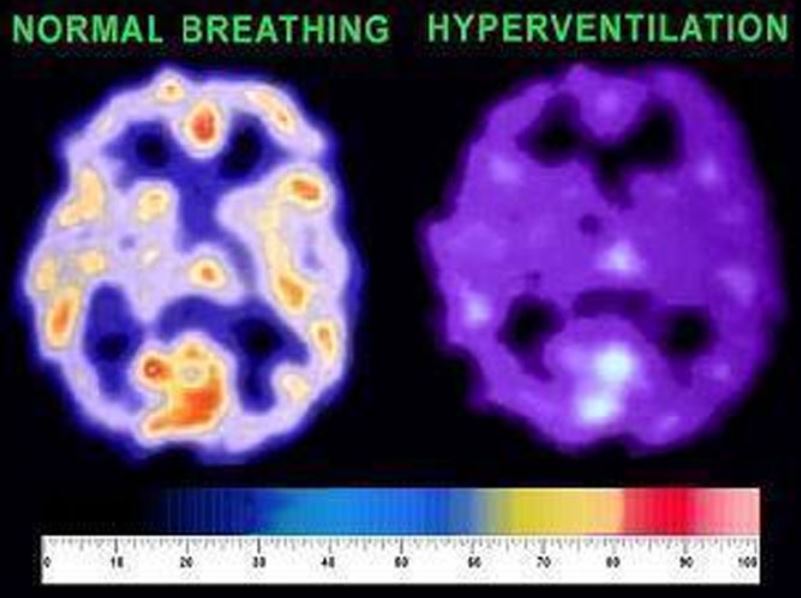
CO2 Effects on Nerve Function
Dr Meduna who wrote an entire book on co2 therapy (Carbon Dioxide Therapy – A Neurophysiological Treatment of Nervous Disorders by L.J. Meduna M.D published in 1950.) discovered that additional co2 had notable effects on nerve function.
CO2 produces the following changes:
(1) increase in the member potential;
(2) increase in the threshold of stimulation;
(3) increase in ability to release energy
(4) decrease in fatigability
A more general description of the effect of CO2 upon the functional ability of the nerve is given by Lorente de No:
1. The ability of the nerve fibers to release energy which is required to maintain the flow of the demarcation current or what amounts to the same thing — to withstand without failure the effect of an applied cathodal current is increased markedly by the presence of 5% CO2 in the atmosphere of the nerve;
2. CO2 increases the ability of the nerve to conduct trains of impulses because the presence of 5% CO2 in the atmosphere of the nerve noticeably delays the appearance of the signs of failure, namely, increase of threshold, decrease of speed of conduction, decrease of the height of the spike.
Thus, it can be said that the presence of 5% CO2 increases the ability of the nerve to perform work, undoubtedly because the enzymatic mechanisms of the nerve utilize stores of metabolic energy more readily or more effectively in the presence than in the absence of a certain concentration.
The presence of CO2 in the atmosphere of the nerve not only increases the value of the membrane potential of the resting nerve, but also prevents the progressive depolarization of the nerve during tetanic stimulation.”
breath the desired level of co2 combined with regular air. It allows you to breath higher levels of co2 than is attainable with bag breathing. Some of the best results from the work of L.J. Meduna, Albert LaVerne, Yandell Henderson and modern day research with cancer have been used with levels exceeding 5%. With the carbogen generator you can work your way up to hire levels of breathing co2 at your own pace
Humidified Warmed CO2 Treatment Therapy Strategies Can Save Lives With Mitigation and Suppression of SARS-CoV-2 Infection: An Evidence Review
“Carbon dioxide is safe and superior antimicrobial, which suggests it should be effective against coronaviruses and mutants thereof. Depending on the therapeutic regime, CO2 could also ameliorate other COVID-19 symptoms as it has also been reported to have antioxidant, anti-inflammation, anti-cytokine effects, and to stimulate the human immune system. Moreover, CO2 has beneficial effects on respiratory physiology, cardiovascular health, and human nervous systems.”
Benefits of Hypercapnic Therapy
patients with advanced lung disease.
Hypercapnic acidosis, but not buffered hypercapnia, was reported to reduce the severity of sepsis-induced lung injury
Recent studies suggest that HCA is protective in the earlier phases of bacterial pneumonia-induced sepsis, just as HCA is protective in preclinical models of early and prolonged systemic sepsis
CO2 gas in therapeutic hypercapnia and other forms of acidosis techniques is an excellent antioxidant and anti-inflammatory agent
Hypercapnic acidosis was associated with benefits on lung and distant organs in several disease models, apart from the reduction of ventilation parameters such as ventilator-induced lung injury (73), acute respiratory distress syndrome (ARDS) (74), ischemia-reperfusion injury (75) and sepsis (76),
Therapeutic hypercapnia through inspired carbon dioxide attenuated lung injury, as measured by gas exchange, reduced cytokine release, lung oedema formation, and histological lung injury.
Hypercapnic acidosis improves ventilation-perfusion matching that also improves gas exchange (77), prevents oedema formation (78), clears the alveolar fluid in pulmonary oedema (79), maintains the integrity of the blood-brain-barrier and reduces neurologic deficits after trauma (80)
HCA also reduces the oxidative stress that contributes to pathologic thick mucus gel formation in the lung (81, 82)”
Yandell Henderson talks about the getting the benefits of exercise with breathing co2 without the negatives. He wrote about this in 1931 in the American Heart Journal.
When a Healthy Person Exercises
“The general conception under which these observations were made was as follows: In a normal person muscular exertion induces no pain either in a limb or in the heart, for the reason that the blood supply is sufficient to afford all the oxygen needed initially in the working parts. This supply of oxygen quickly converts a large part of the fatigue products, especially lactic acid, into carbon dioxide. The carbon dioxide then induces a relaxation of the blood vessels and thus increases the blood supply to the working parts, both heart and limbs. This is the normal reaction to exercise. The healthy man takes a walk or plays an athletic game to improve the oxygenation of his tissues. Thus as Miescher” said forty-five years ago : “Carbon dioxide spreads its protecting wings over the oxygen supply of the body.”
When an Unhealthy Person Exercises
“Quite different, is the reaction in a person in whose heart or limbs the blood vessels are sclerotic or constantly contracted. The blood supply and therefore the oxygen supply are insufficient for the initial requirements of exertion. Lactic acid and other fatigue products accumulate; for in the absence of a large supply of oxygen they cannot be burned to carbon dioxide. They tend to induce a cramp of the musculature, cardiac or striated, in contrast to the influence of carbon dioxide which, as I long ago demonstrated experimentally on the heart, promotes relaxation.6 To do effective work a muscle must be able to relax as well as to contract. From excess of lactic acid and local deficiency of carbon dioxide come the abnormal reaction to exercise, the ischemia and the cramp.”
The Benefits of Breathing CO2 over Exercise
“If now a patient who is liable to such an abnormal reaction receives an inhalation of carbon dioxide, still a third form of reaction develops. He experiences the benefits, without the disadvantages, of physical exercise. He makes no exertion. His muscles are at rest, and his heart is put, under no additional strain. There is no decrease of the oxygen supply to any part, but rather an increase, for the carbon dioxide inhaled induces a relaxation of the finer blood vessels, a more ample heartbeat, and a fuller circulation. The balance of supply and demand for oxygen in the tissues is thus distinctly improved and the tendency to cramp is diminished. Furthermore as the treatment is repeated day after day the blood vessels and the heart muscle, under the influence of a
Carbon dioxide has a direct effect on increasing your resiliency to handling stress and producing energy
Meduna in 1950 (CARBON DIOXIDE THERAPY – A NEUROPHYSIOLOGICAL TREATMENT OF NERVOUS DISORDERS) observed the following changes to nerve cells in the presence of higher co2.
1. Increase in the member potential.
2. Increase in the threshold of stimulation.
3. Increase in ability to release energy.
4. Decrease in fatigability
A more general description of the effect of CO2 upon the functional ability of the nerve is given by Lorente de No:
1. The ability of the nerve fibers to release energy which is required to maintain the flow of the demarcation current or what amounts to the same thing to withstand without failure the effect of an applied cathodal current is increased markedly by the presence of 5% CO2 in the atmosphere of the nerve.
2. CO2 increases the ability of the nerve to conduct trains of impulses because the presence of 5% CO2 in the atmosphere of the nerve noticeably delays the appearance of the signs of failure, namely, increase of threshold, decrease of speed of conduction, decrease of the height of the spike.
Thus, it can be said that the presence of 5% CO2 increases the ability of the nerve to perform work, undoubtedly because the enzymatic mechanisms of the nerve utilize stores of metabolic energy more readily or more effectively in the presence than in the absence of a certain concentration. The presence of CO2 in the atmosphere of

the nerve not only increases the value of the membrane potential of the resting nerve, but also prevents the progressive depolarization of the nerve during tetanic stimulation.
What You May Experience
While breathing higher levels of co2 it stimulates respiration. So you may breathe much faster and pant almost like you just finished a sprint. As your body adapts you will be able to breath higher levels of co2 without panting or breathing fast. Generally
it is a pleasant experience and it feels like your interior is being massaged. As described below there may often be some pleasant psychological material as well as the awakening of certain aspects of the subconscious. You should never exceed 10% for very long as it could potentially result in unconsciousness.
Breathing a carbogen mixture of 5% carbon dioxide has been shown in many studies to increase oxygen utilization in hypoxic conditions.
Anxiety
“O2 inhalation has been used for many years in the treatment of various psychiatric and medical disorders and different rationales for its effect have been offered. Since it has been recently found that CO2 inhibits thromboxane biosynthesis and raises levels of prostacyclin”
Thromboxane is released from the blood platelets and induces platelet aggregation and arterial constriction. Thromboxane is inhibited through inhalation of carbogen.
Prostacyclin, which is increased with CO2 inhalation, is a prostaglandin in the eicosanoid family of lipid molecules. It inhibits platelet activation and is also an effective vasodilator. It does this by raising cyclic AMP levels.
“CO2 produced a significant reduction of fear of autonomic panic sensations, state and trait anxiety, agoraphobic anxiety and avoidance, and of the frequency of panicking. “
“In respiratory relief, satisfaction of the need to breathe is paired with presentation of the phobic stimulus. 2 cases illustrating the use of carbon dioxide inhalations to increase the need to breathe are described. A spider phobia was quickly removed in a 24-yr-old man, and with 15 sessions of respiratory relief, a woman aged 26 with a severe obsessional compulsive neurosis exhibited marked improvement. Augmenting with CO2 is simple and appears to speed the therapeutic effect.”
Seizures
“Further, individual therapeutic interventions demonstrated that a pCO2-elevation via re-breathing or inhalation of 5% CO2 instantly stopped the febrile seizures.”
“Five percent CO₂ has a fast and potent anticonvulsant action. The present data suggest that medical carbogen with 5% CO₂ can be used for acute treatment to suppress seizures in epilepsy patients.”

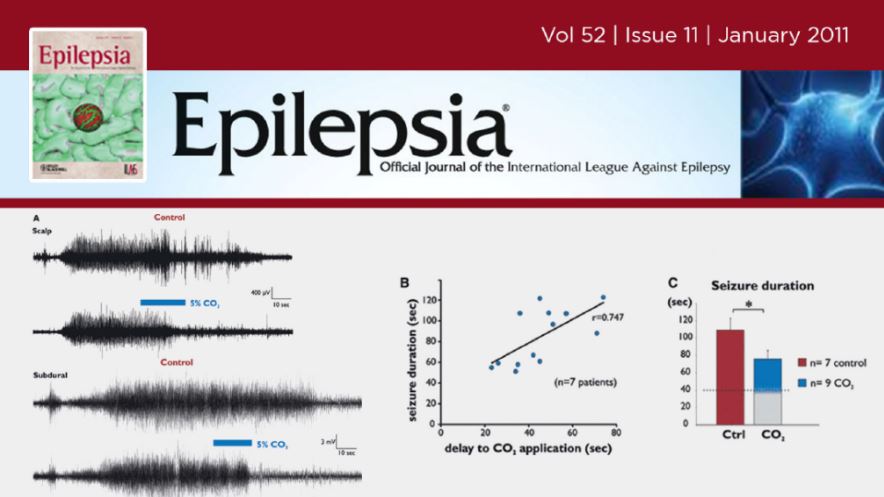
FREQUENTLY ASKED QUESTIONS
You can get the CO2 tanks from Amazon or a local supplier at a welding supply store. Most restaurants, gas stations, convenience stores, movie theaters etc get their tanks and refills from local welding supply stores in order to provide their fountain drinks.
You can also use the SodaStream canister which are more convenient to get but do not last as long as the tank. You can get these from Amazon or from local stores such as Target, Walmart, Meijer etc.
The CO2 inhaler comes with the machine that controls the CO2 levels, a breathing hose, small and large masks, 12v power adapter and a regulator and adapter that can be used for both a normal CO2 tank 5, 10, 20 and 50lbs or a soda stream canister.
The cost to refill a 5lb tank is not four times less than the 20lb tank so there is a cost savings with the 20lb tank though it’s heavier and not as easy to move around if you need to. Additionally the carbogen breathing machine you can also use a soda stream canister. I won’t last as long but it’s very convenient and easily portable. Both purchases come with the regulator you need for the normal CO2 tank or soda stream.
The CO2inhaler has not been approved to diagnose, cure or treat any diseases. It is designed to help you be healthier, improve sports performance and increase relaxation. There have been no studies using this device and any studies using CO2 were using specific protocols and controlling different factors in the study that may not be suitable for real-world situations.
It is recommended to do short sessions for 5 or 10 minutes throughout the day to help boost your energy and reduce stress and anxiety. You can do a low amount for the duration or increase the amount for short periods of time into the red zone and then go back down again. For example go up to 5% for 30 seconds to a minute and then go back down to something more comfortable. Similar to interval training. The increase in diaphragmatic breathing is beneficial. You don’t want to overdue it though, so listen to your body. If it feels too much then reduce the amount or take a break.
Many customers will have the machine at their desk while working and do short 5 to 10 minute sessions throughout the day. Others will have it by their chair they sit in while watching TV for example.
Make sure you tighten the regulator on the SodaStream canister tight enough. In some situations it may require an adjustable wrench to tighten it enough.

